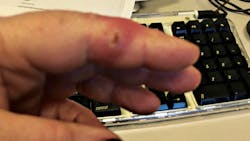A couple of years ago at an event for the hand safety campaign Zero Excuses, David Lynn, a former OSHA compliance officer and corporate EHS manager, explained that the elements for building a workplace hand safety program include trend analysis, hazard assessment, training, communication, planning, compliance and follow-through.
A hand safety program begins with tracking hand injuries and analyzing the data for trends. It's not just about analyzing the types of hand injuries that are occurring, Lynn explained. It's also important to know what types of job tasks workers are involved in when they hurt their hands.
For example, in his consulting work with one company, Lynn's analysis revealed that many hand injuries were occurring while workers operated tools and equipment.
"So we were able to extrapolate the trends out of those injuries and begin to see where the issues were," he explained.
During his talk, Lynn "got real" with the audience, sharing his own lapse in hand safety judgment, which involved carving a piece of plastic with a box cutter-type knife and several stitches. While he laughs about it now, Lynn acknowledges he knew better and made a poor choice.
And if he can make a poor choice, so can employees, which is why training and ongoing messaging about hand safety are so important, he emphasized.
Like Lynn, I understand that hand injuries often occur because the wrong tools are used, the correct tools are being used improperly and/or hand protection is not being worn. Which brings me to my role in this hand safety tale…
I'm a gardener. I use sharp tools in the garden to cut branches, flower stems, roots... you name it. I am the proud owner of a garage full of gardening tools, all designed for different tasks.
I also am the proud owner of at least 10 pairs of gloves, all of which were designed for various industrial uses but make stellar gardening gloves. I swear the following are not paid product placements, like a Pepsi can in a film, but I want to give you an idea of what we're talking about here…
When moving stones or other heavy objects in the garden, I use a pair of Ergodyne mechanics' gloves, for example, because they offer protection to the back of my hand and keep me from bruising my knuckles. I have a variety of hand protection options from MCR Safety, Banom, Protective Industrial Products and Ansell that offer cut and puncture protection and/or special grip features for the palm and fingers that I use for pulling weeds and digging holes. I wear gloves that feature special cut-resistant fibers from Dyneema that are thin enough to allow me to freely move my fingers. I even use examination-type gloves from SHOWA and other companies to keep my hands dry under my garden gloves if it's raining or soggy outside.
In other words, thanks to the trade shows I attend every year, I have the latest and greatest offerings from pretty much every glove and fiber manufacturer in the United States.
So, combine the best in hand protection technology, an arsenal of appropriate tools and knowledge about hand safety and what do I get? An injury.
I cannot blame any of the PPE or tools. I chose to try to loosen the very tight roots of a lavender plant with a pair of garden scissors, rather than the two or three (not sharp) tools I have for that purpose. I chose to "operate" on the plant without wearing gloves, because it was a spur of the moment decision and I didn't want to walk back to the garage to grab a pair.
Long story short, I stabbed my finger to the bone with the sharp point of the scissors, it got infected and I nearly ended up in the hospital tethered to an IV of antibiotics.
I was unable to bend my index finger – let alone garden – for three weeks. It's still not 100 percent but it's on the mend. And for the next couple of years at least, the scar will serve as a reminder to wear gloves and choose the right tool for the job.
About the Author

Sandy Smith
Sandy Smith is the former content director of EHS Today, and is currently the EHSQ content & community lead at Intelex Technologies Inc. She has written about occupational safety and health and environmental issues since 1990.
